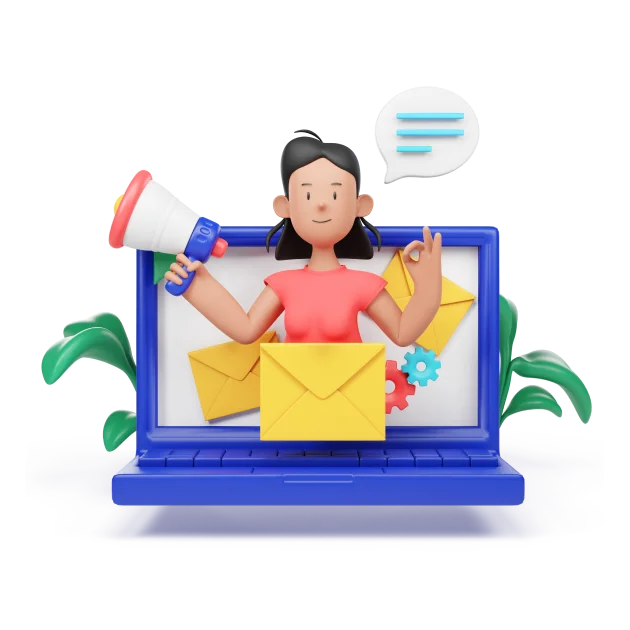Storytelling emails are a powerful tool in the realm of email marketing. There are many different types of content out there, each with its own creative process. Content developers might be creating everything from whitepapers with thousands of words to pay-per-click advertising with only a few phrases. What do all of these things have in common?
They may both be used to convey a story. Email marketing is generally somewhere in between long-form material with a lot of details and basic advertising that is purposely designed to be brief. It should come as no surprise that narrative is also a viable option to explore here. Let’s create your storytelling email to make sure we’re on the right road.
The Importance of Storytelling in Email Marketing
Why Use Storytelling Emails?
Storytelling emails are not just about selling a product or a service. They are about engaging your audience on a deeper level. When you use storytelling in email marketing, you create a narrative that your audience can relate to, which makes your emails more memorable and impactful. This technique helps in building a strong connection with your readers, making them more likely to engage with your content and take the desired action.
The Power of Narrative in Marketing
A well-crafted story can make your email stand out in a crowded inbox. Stories are a fundamental part of human communication, and they have been used for centuries to convey messages and information. By incorporating storytelling for emails, you tap into this powerful tool, making your messages more compelling.
Historical Context of Storytelling Emails
The concept of storytelling is not new; it has been an integral part of human interaction since ancient times. Historical emails, although not commonly referenced, have always played a role in conveying messages and preserving history through written communication. By leveraging this age-old practice, you can enhance your email marketing strategy significantly.
Crafting Your Storytelling Email
Make Use of People to Tell the Story
Relatable characters are at the heart of every story. A relevant name with which a narrative begins immediately establishes a bond between the reader and the story. A name in the subject line also generates immediate interest. Similarly, having names in a story allows the listener or reader to begin picturing everything that is stated, allowing them to better understand the plot and making it more credible.
The most difficult difficulty in email marketing is getting the subject line to be interesting enough so that the user opens the email and reads it. This barrier is readily overcome if your topic line contains the name of a character. For example, if your subject line reads, “Find out how Tom saved more than 1000 USD with us,” it should be more appealing than just stating, “People have saved 1000 USD.” Using names helps to make the story more credible. Try to test different subject lines and track what topics are more useful for a particular industry.
Developing a Compelling Narrative
To create a successful storytelling email, you need to develop a compelling narrative that resonates with your audience. This involves understanding your audience’s needs and interests and crafting a story that addresses these. Your story should have a clear beginning, middle, and end, with a strong emotional hook to keep your readers engaged.
Email Storytelling Techniques
When it comes to email storytelling, there are several techniques you can use to make your narrative more engaging. One effective method is to use descriptive language that paints a vivid picture in the reader’s mind. Another approach is to incorporate dialogue, which can make the story feel more dynamic and relatable. Additionally, using a consistent tone and voice throughout your email can help maintain the reader’s interest and create a cohesive narrative.
Never Use Your Email to Make a Sales Pitch
Every hour of the day, one sees advertising starting at the beginning of the day. Advertisements abound on the internet, in newspapers, and on billboards all around us; everyone is attempting to sell us something. If your email also includes a sales pitch on the unique selling points of your products and services, the user is unlikely to read it all the way through.
Email marketing is not intended to be a sales pitch for your product, but rather to register your brand in the reader’s memory and develop a relationship with the consumer. You must create a story around your product for consumers to be interested in your email.
Storytelling Email Marketing Best Practices
To maximize the effectiveness of your storytelling email marketing efforts, it’s important to follow best practices. This includes ensuring that your story is relevant to your audience, using a clear and concise writing style, and incorporating visual elements such as images and videos to enhance the narrative. Additionally, it’s important to test different approaches and analyze the results to continuously improve your strategy.
Enhancing Engagement with Storytelling
Tell About Your Experience
A story about a personal event has a huge influence on the user. It engrosses the reader. Photographs and videos are attached in emails where the user may see the user has a greater influence on the user. A personalized story makes an impact on the reader and easily motivates the user to click on the call to action, to reach your email marketing goal. Sharing a personal narrative also helps to retain clients since they realize they have something more to give than you have and choose to continue with you.
Creating Emotional Connections
One of the key benefits of email storytelling is its ability to create emotional connections with your audience. By sharing stories that evoke emotions such as joy, sadness, or inspiration, you can create a deeper bond with your readers. This emotional connection can lead to increased loyalty and engagement, as your audience feels more connected to your brand.
The Role of Authenticity in Storytelling
Authenticity is crucial in storytelling. Readers can easily detect when a story feels forced or insincere. To build trust and credibility, make sure your stories are genuine and reflect your brand’s values and mission. Authentic storytelling not only enhances your brand image but also fosters a deeper connection with your audience.
Leveraging User-Generated Content
Another effective way to incorporate storytelling in email marketing is by leveraging user-generated content. This can include testimonials, reviews, and success stories from your customers. User-generated content adds an extra layer of credibility to your emails, as it showcases real experiences and outcomes from your audience.
The next part of the article will continue to explore additional techniques and strategies for effective storytelling in email marketing, including detailed case studies, behind-the-scenes stories, and more. By integrating these elements, you can create a comprehensive approach to storytelling that maximizes engagement and drives better results for your email marketing campaigns.
Examples of Effective Storytelling Emails
Case Studies and Testimonials
One effective way to incorporate storytelling in email marketing is through case studies and testimonials. These real-life examples provide concrete evidence of how your product or service has benefited others, making your story more credible and relatable. For instance, a storytelling email might detail how a small business owner used your software to streamline operations and increase revenue. By sharing these success stories, you not only highlight the effectiveness of your products but also inspire your audience with real-world examples.
Behind-the-Scenes Stories
Another approach is to share behind-the-scenes stories about your company or team. This can humanize your brand and give your audience a glimpse into the people and processes behind your products or services. For example, you could write an email about the journey of developing a new product, including the challenges faced and the innovative solutions your team came up with. These stories not only engage your audience but also build a sense of transparency and trust.
Thematic Storytelling Campaigns
Thematic storytelling campaigns involve creating a series of emails that follow a consistent theme or narrative arc. This approach keeps your audience engaged over a longer period and encourages them to look forward to your next email. For example, you could develop a campaign that tells the story of a fictional character who represents your target customer. Each email could explore different aspects of their journey and how your product or service plays a role in their success.
Measuring the Impact of Storytelling Emails
Analyzing Engagement Metrics
To determine the effectiveness of your storytelling emails, it’s important to analyze engagement metrics such as open rates, click-through rates, and conversion rates. These metrics can provide insights into how well your stories are resonating with your audience and whether they are driving the desired actions. For example, if you notice a high open rate but a low click-through rate, it might indicate that your subject lines are compelling, but the content of your emails needs improvement.
A/B Testing Different Storytelling Approaches
A/B testing can also be useful in optimizing your storytelling emails. By testing different subject lines, story formats, and calls to action, you can identify what works best for your audience and refine your approach accordingly. For instance, you might test whether a personal anecdote or a customer testimonial generates more engagement. The insights gained from A/B testing can help you craft more effective storytelling emails in the future.
Gathering Feedback from Your Audience
In addition to analyzing metrics, gathering direct feedback from your audience can provide valuable insights into the impact of your storytelling emails. You can include surveys or polls in your emails to ask your subscribers what they enjoyed about the story, what they found less engaging, and what types of stories they would like to see in the future. This feedback can help you tailor your content to better meet the preferences and interests of your audience.
Advanced Storytelling Techniques
Incorporating Visual Storytelling Elements
Visual elements such as images, infographics, and videos can enhance your storytelling emails by making them more engaging and easier to understand. For example, you could include an infographic that illustrates the key points of your story or a short video that brings your narrative to life. Visual storytelling can break up long blocks of text and provide a more dynamic and immersive experience for your readers.
Using Interactive Storytelling Features
Interactive features such as polls, quizzes, and clickable elements can further engage your audience and make your storytelling emails more interactive. For example, you could include a quiz at the end of your email that relates to the story, encouraging readers to participate and learn more about your products or services. Interactive storytelling not only keeps your audience engaged but also provides valuable data on their preferences and behaviors.
Personalizing Your Storytelling Emails
Personalization is key to making your storytelling emails resonate with your audience. By tailoring your stories to the specific interests and needs of your subscribers, you can create a more relevant and engaging experience. This can involve segmenting your email list based on demographics, past behaviors, or preferences and crafting stories that speak directly to each segment. For instance, a storytelling email for new subscribers might focus on introductory content, while an email for long-time customers could highlight advanced features or new product updates.
Conclusion
I hope you enjoyed our suggestions, and I hope to see you back here in a week to complete my story. By incorporating storytelling into your email marketing strategy, you can create more engaging and memorable emails that resonate with your audience and drive better results. Whether you are sharing personal experiences, case studies, or behind-the-scenes stories, storytelling can help you connect with your readers on a deeper level and achieve your marketing goals.
Final Thoughts on Storytelling for Emails
By using these techniques, you can make your storytelling emails a powerful tool in your email marketing arsenal. Remember that the key to successful storytelling in email marketing is to be authentic, engaging, and relevant to your audience. Continuously experiment with different storytelling approaches, measure the results, and refine your strategy to ensure that your emails remain compelling. With the right approach, storytelling can transform your email marketing efforts and help you build stronger relationships with your audience.




